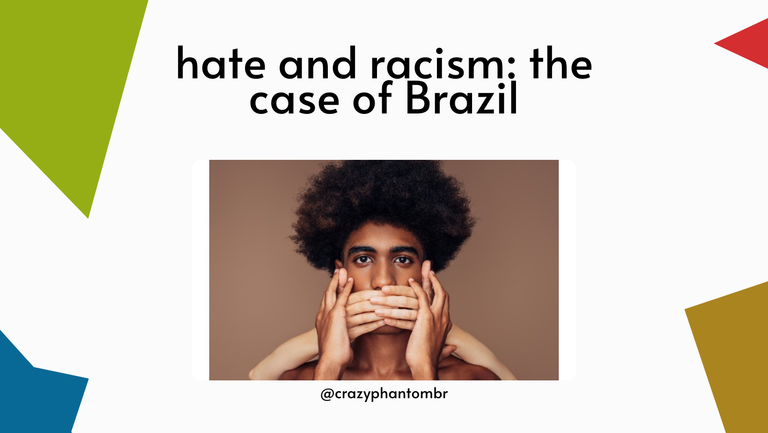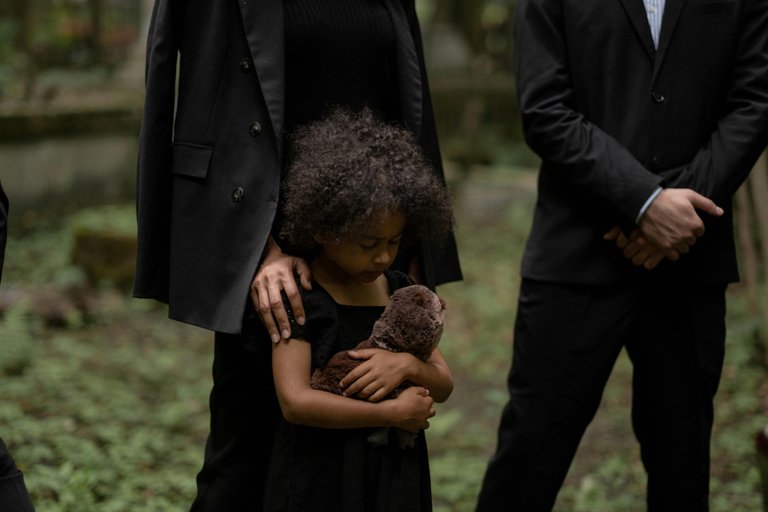
Written in Portuguese. EN by Google / Image Source
To my ever-loving friends in the HiveLearners community, my warmest regards!
Modern society has evolved into a social consensus that is often held together by a thin membrane that seems like it could break at any moment. A kind of tension has taken over our daily lives, causing mental-related illnesses to become increasingly common.
Sometimes it seems like there is a kind of persecution against people, customs or socioeconomic characteristics. You'll understand what I'm talking about soon.
Come with me!

A look at the Brazilian population
Here in Brazil we have a mixed population, which was formed by the original peoples indigenous people who lived here before the landing of the European sailboats, who brought a white population, with distinct customs and habits. As if their arrival and all the dispute over territory were not enough, the white Europeans went in search of another population, with also different traits, which are the African peoples.
Thus, the native Latin Americans were persecuted and exterminated, in each village, almost reaching extinction. The African peoples were enslaved and later left to their own devices, being replaced by new populations of European migrants (now called workers).
The mixture of these races created the Brazilian people, which is mostly composed of black or mixed-race people. Data from IBGE (Brazilian Institute of Geography and Statistics) indicate that:
- 92.1 million people (45.3%) declared themselves mixed-race;
- 88.2 million (43.5%) declared themselves white;
- 20.6 million (10.2%) declared themselves black;
- 1.7 million (0.8%) declared themselves indigenous and
- 850.1 thousand (0.4%) declared themselves yellow.
It is important to note that the ships coming from Europe bringing "white workers" to replace the black slaves, whether they were Italian or German, in any case, ended up contributing to the increase in the self-declared white population. And this is important, because the problem begins with the dispute between this white working population, which sees blacks and indigenous people as inferior beings.
The black people, discarded after the end of slavery in Brazil (1888), were labeled as those who do not work.
The indigenous people, native people without the culture of accumulation, were labeled as lazy.

Hate and racism in Brazil: internal racism
Non-white populations have historically been attacked by hate speech, bullying, and violence: assault and murder. Data from IBGE indicate that the homicide rate in the country among black or brown people is 43.4 deaths for every 100,000 inhabitants. For comparison purposes, the homicide rate among white people is 16 for every 100,000 inhabitants.
In simple terms, it is 3 to 1: three black/brown people die while one white person dies.
 The color of death: black/brown people die almost three times more than white people in homicides in Brazil / Pexel
The color of death: black/brown people die almost three times more than white people in homicides in Brazil / Pexel
It seems logical that to change the current scenario we need to work with the new generations, minimizing the imitation of cultural habits that insist on reproducing an archaic society and that harass entire population groups by simple repetition.
To this end, we see awareness campaigns and projects, of what is conventionally called anti-racist educational policies. In this way, school-age children and young people have access to debate the topic and act on their reality, acting as a factor for social change.
We understand that anti-racist educational policies are those that seek to contribute to overcoming racism in the educational context, combating forms of hierarchy, discrimination and prejudice present in the curriculum and school practices, and positively promoting minority groups.
To address these statistics and change the reality of the country, government actions have been implemented, and I highlight the last one on this list:
- Law No. 7,716, of January 5, 1989 -Defines crimes resulting from racial or color prejudice.
- Law No. 12,288, of July 20, 2010 - Institutes the Statute of Racial Equality.
- Law No. 12,527, of November 18, 2011 - Regulates access to information (LAI).
- Law No. 14,532, of January 11, 2023 - Classifies racial insult as a crime of racism.
This is where we conclude this article, noting that *racism and racial insult8 are crimes in Brazil, and the practice of any of these actions should result in the reporting, prosecution and accountability of the aggressor.
Hate and Racism in Football: External Racism
The title of this section could be: Europeans attack Brazilians. I will not translate this infographic. It shows a timeline of Brazilian players who have suffered racism in international football. You will see that stars like Vini Junior have recurring participation.

Image Source: Agência Brasil (government)
Conclusion
Considering the strength of the law, the tolerance limit for acts of racism or racial insult is zero. There is no tolerance. Any manifestation of hatred motivated by a person's race or color will be dealt with to the fullest extent of the law.
What do you think?


Escrito em Português. EN by Google / Image Source
Aos meu sempre amigos da comunidade HiveLearners, minhas melhores saudações!
A sociedade moderna evoluiu para um consenso social que muitas vezes se mantém por uma fina membrana, que parece poder romper a qualquer momento. Uma espécie de tensão tomou conta de nosso dia a dia, fazendo com que doenças relacionadas à mente se tornassem cada vez mais frequentes.
As vezes parece que existe uma espécie de perseguição contra pessoas, costumes ou características socioeconômicas. Você vai entender sobre o que eu estou falando logo.
Vem comigo!

Uma olhar sobre a população brasileira
Aqui no Brasil temos uma população mista, que foi formada pelos povos originários indígenas que aqui habitavam antes do desembarque dos veleiros europeus, que trouxeram uma população de cor branca, com costumes e hábitos distintos. Não bastasse sua chegada e toda a disputa por território, os brancos europeus foram buscar outra população, com traços também diferentes, que são os povos africanos.
Assim, os nativos latino americanos foram perseguidos e exterminados, em cada povoado, chegando quase à extinção. Os povos africanos foram escravizados e posteriormente largados à própria sorte, sendo substituídos por novas populações de migrantes europeus (agora chamados de trabalhadores).
A mistura dessas raças criou o povo brasileiro, que é composto em sua maioria pela população negra ou parda. Dados do IBGE (Instituto Brasileiro de Geografia e Estatística) apontam que:
- 92,1 milhões de pessoas (45,3%) se declararam pardas.;
- 88,2 milhões (43,5%) se declararam brancos;
- 20,6 milhões (10,2%) se declaram pretos;
- 1,7 milhões (0,8%) se declararam indígenas e
- 850,1 mil (0,4%) se declararam amarelas.
É importante notar que os navios vindo da Europa trazendo "brancos trabalhadores" para substituir os escravos negros, sejam eles italianos ou alemães, de qualquer forma, acabaram por colaborar com o incremento da população auto declarada branca. E isso é importante, pois o problema começa pela disputa entre essa população branca trabalhadora, que vê no negro e no índio um ser inferior.
O negro, descartado após o fim da escravidão no Brasil (1888), rotulado como quem não trabalha.
O índio, povos originários sem a cultura do acúmulo, rotulado de preguiçoso.

Ódio e racismo no Brasil: racismo interno
As populações não brancas tem sido historicamente atacadas por discursos de ódio, pelo bulling, pela violência: agressão e assassinato. Dados do IBGE apontam que a taxas de homicídio no país entre pessoas pretas ou pardas é de 43,4 mortes para cada 100 mil habitantes. Para fins de comparação, a taxa de homicídios entre pessoas brancas é de 16 para cada 100 mil habitantes.
Em linhas mais simples, é 3 para 1: morrem três pretos / pardos enquanto morre um branco.
 A cor da morte: população negra / parda morre quase três vezes mais que os brancos em homicídios no Brasil / Pexel
A cor da morte: população negra / parda morre quase três vezes mais que os brancos em homicídios no Brasil / Pexel
Parece coerente que para mudar o cenário atual precisamos trabalhar com as novas gerações, minimizando a mimetização dos hábitos culturais que insistem em reproduzir uma sociedade arcaica e que assedia grupos populacionais inteiros pela simples repetição.
Para isto percebemos campanhas e projetos de conscientização, daquilo que se convenciona chamar de políticas educacionais antirracistas. Dessa forma, as crianças e jovens em idade escolar tem acesso para debater o tema e atuar sobre a sua realidade, agindo como um fator de mudança social.
Entendemos que políticas educacionais antirracistas são aquelas que buscam contribuir para a superação do racismo no contexto educacional, combatendo formas de hierarquização, discriminações e preconceitos presentes no currículo e nas práticas escolares, e promovendo positivamente grupos minoritários.
(SANTOS, 2019)
Para enfrentar esses dados estatísticos e mudar a realidade do país, ações governamentais tem sido implementadas, e eu destaco a última desta lista:
- Lei nº 7.716, de 5 de janeiro de 1989 - Define os crimes resultantes de preconceito de raça ou de cor.
- Lei nº 12.288, de 20 de julho de 2010 - Institui o Estatuto da Igualdade Racial.
- Lei nº 12.527, de 18 de novembro de 2011 - Regula o acesso à informação (LAI).
- Lei nº 14.532, de 11 de janeiro de 2023 - Tipifica como crime de racismo a injúria racial.
É nesse ponto que fechamos este artigo, ao observar que o *racismo e a injúria racial8 são crimes no Brasil, sendo que a prática de qualquer destas ações deve resultar na denúncia, processo e responsabilização do agressor.
Ódio e Racismo no Futebol: racismo exteno
O título dessa seção poderia ser: Europeus agridem brasileiros. Não irei traduzir esse infográfico. Ele mostra uma linha do tempo de jogadores brasileiros que sofreram com racismo no futebol internacional. Você vai ver que estrelas como Vini Junior tem participação recorrente.

Image Source: Agência Brasil (governamental)
Conclusão
Tendo em vista a força da lei, o limite de tolerância para prática de atos de racismo ou injúria racial é zero. Não há tolerância. Qualquer manifestação de ódio motivada pela raça ou cor da pessoal será tratada no rigor da lei.
E você o que acha?


Posted Using INLEO






